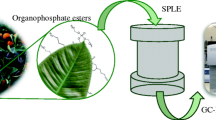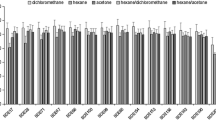Abstract
A selective analytical method for the determination of nine organophosphate triesters and triphenylphosphine oxide (TPPO) in outdoor particulate matter is presented. It involves a fully automated pressurised liquid extraction (PLE) step, integrating an alumina clean-up process, and subsequent determination by large-volume injection gas chromatography–positive chemical ionisation–tandem mass spectrometry (LVI-GC–PCI–MS/MS). The extraction variables (solvent, amount of adsorbent, temperature, time and number of cycles) were optimised using a multicriteria strategy which implements a desirability function that maximises both extraction and clean-up efficiencies while searching for the best-compromise PLE conditions. The final method affords quantification limits of between 0.01 and 0.3 μg g−1 and recoveries of >80%, with the exceptions of the most polar analytes, TCEP and TPPO (~65%) for both urban dust and PM10 samples. Moreover, the method permitted the levels of these compounds in dust deposited outdoors (between LOD and 0.5 μg g−1 for TEHP) and PM10 samples (between LOD and 2.4 μg m−3 for TiBP) to be measured and reported for the first time.






Similar content being viewed by others
References
European Flame Retardants Association (2007) Website. http://www.cefic-efra.com. Cited 9th May 2007
Marklund A (2005) Ph.D. Thesis. Umeå University, Umeå
Rodil R, Quintana JB, Reemtsma T (2005) Anal Chem 77:3083–3089
Meyer J, Bester K (2004) J Environ Monit 6:599–605
Marklund A, Andersson B, Haglund P (2005) Environ Sci Technol 39:7423–7429
Rodríguez I, Calvo F, Quintana JB, Rubí E, Rodil R, Cela R (2006) J Chromatogr A 1108:158–165
Andresen JA, Grundmann A, Bester K (2004) Sci Total Environ 332:155–166
Quintana JB, Reemtsma T (2006) J Chromatogr A 1124:22–28
Andresen J, Bester K (2006) Water Res 40:621–629
Marklund A, Andersson B, Haglund P (2005) J Environ Monit 7:814–819
Marklund A, Andersson B, Haglund P (2003) Chemosphere 53:1137–1146
Carlsson H, Nilsson U, Becker G, Östman C (1997) Environ Sci Technol 31:2931–2936
Staaf T, Östman C (2005) J Environ Monit 7:883–887
Staaf T, Östman C (2005) J Environ Monit 7:344–348
Hartmann PC, Bürgi D, Giger W (2004) Chemosphere 57:781–787
Björklund J, Isetun S, Nilsson U (2004) Rapid Commun Mass Spectrom 18:3079–3083
Isetun S, Nilsson U (2005) Analyst 130:94–98
Marklund A, Andersson B, Haglund P (2005) Environ Sci Technol 39:3555–3562
Bacaloni A, Cavaliere C, Foglia P, Nazzari M, Samperi R, Laganà A (2007) Rapid Commun Mass Spectrom 21:1123–1130
Töllback J, Tamburro D, Crescenzi C, Carlsson H (2006) J Chromatogr A 1129:1–8
Isetun S, Nilsson U, Colmsjö A (2004) Anal Bioanal Chem 380:319–324
Isetun S, Nilsson U, Colmsjö A, Johansson R (2004) Anal Bioanal Chem 378:1847–1853
Fries E, Püttmann W (2003) J Environ Monit 5:346–352
García M, Rodríguez I, Cela R (2007) J Chromatogr A 1152:280–286
Takimoto K, Hirakawa T, Ito K, Mukai T, Okada M (1999) Atmos Environ 33:3191–3200
Björklund E, Sporring S, Wiberg K, Haglund P, von Holst C (2006) Trends Anal Chem 25:318–325
Björklund E, Nilsson T, Bowadt S (2000) Trends Anal Chem 19:434–445
EC (1999) Council Directive 1999/30/EC. Off J Eur Commun L163:41
EC (1998) European standard EN12341: Air quality—determination of the PM10 fraction of suspended particulate matter: reference method and field test procedure to demonstrate reference equivalence of measurement methods. European Communities, Brussels
Fernández-González V, Grueiro-Noche G, Concha-Graña E, Turnes-Carou MI, Muniategui-Lorenzo S, López-Mahía P, Prada-Rodríguez D (2005) Anal Bioanal Chem 383:174–181
Lewis GA, Mathieu D, Phan-Tan-Luu R (1999) Pharmaceutical experimental design in drugs. Marcel Dekker, New York
Pizarro C, Gonzalez-Saiz JM, Perez-Del-Notario N (2006) J Chromatogr A 1132:8–14
Rodríguez I, Quintana JB, Carpinteiro J, Carro AM, Lorenzo RA, Cela R (2003) J Chromatogr A 985:265–274
Syracuse Research Corporation (2007) Database of physicochemical properties. Syracuse Research Corporation, Cicero, NY
Chemical Abstracts Service (2004) SciFinder Scholar Database. http://www.cas.org/products/sfacad/. Cited 9th May 2007
Acknowledgements
J.B.Q. and R.R. acknowledge Xunta de Galicia and Ministerio de Educación y Ciencia for their contract sponsorship through the Isidro Parga Pondal and Juan de la Cierva research programs, respectively. This work was financially supported by Ministerio de Educación y Ciencia (project no. REN2003-08603-C04-01) and Xunta de Galicia (“Programa de consolidación e estruturación de unidades de investigación competitivas, en réxime de concorrencia competitiva 2006”).
Author information
Authors and Affiliations
Corresponding author
Electronic supplementary material
Below is the link to the electronic supplementary material.
ESM 1
(PDF 1.1 MB)
Rights and permissions
About this article
Cite this article
Quintana, J.B., Rodil, R., López-Mahía, P. et al. Optimisation of a selective method for the determination of organophosphorous triesters in outdoor particulate samples by pressurised liquid extraction and large-volume injection gas chromatography–positive chemical ionisation–tandem mass spectrometry. Anal Bioanal Chem 388, 1283–1293 (2007). https://doi.org/10.1007/s00216-007-1338-4
Received:
Revised:
Accepted:
Published:
Issue Date:
DOI: https://doi.org/10.1007/s00216-007-1338-4




